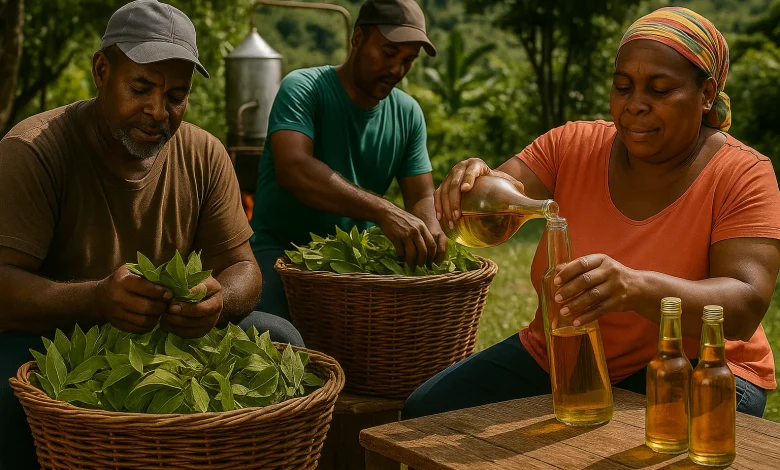Bay Rum

Bay Rum is a fragrant spirit historically crafted from bay leaves and premium rum, originating in the Caribbean but made famous by Dominica’s long-standing tradition of exporting high-quality aromatic blends. Known globally for its spicy, refreshing scent with clove and citrus notes, bay rum has been used for centuries as a grooming tonic, cologne, and natural antiseptic. Its legacy draws deeply from Dominica’s fertile volcanic soils, small distillers and the resilience of local agricultural communities.
Bay Rum from Dominica
Bay rum from Dominica is closely tied to the island’s agricultural and cultural heritage, particularly through the production of bay oil, a key ingredient distilled from the leaves of the Pimenta racemosa tree. Like essential oils, bay rum developed into a valuable export good that supported rural livelihoods and contributed to national income. Since the 1900s, distilleries in coastal villages and inland valleys have transformed hand-harvested bay leaves into high-demand products shipped to North America, Europe, and the Caribbean.
In areas such as Petite Savanne, Layou Valley, and Soufrière, families historically gathered bay leaves, carried them by foot to nearby distilleries and traded them as a seasonal income source. The resulting oil was blended locally with light rum or exported in bulk to international manufacturers. Today, the industry is anchored by the Dominica Essential Oils & Spices Cooperative Society Ltd, which supports small producers and coordinates export volumes.
Bay rum is commonly used as:
- Aftershave and cologne
- Hair and beard tonic
- Topical antiseptic and soothing rub
- Spa aromatherapy oil
It also features in boutique rum cocktails and culinary fusions, showing the versatility of this uniquely Dominican product.
Historical Export and Manufacturing Significance
During the mid-20th century, bay rum became one of Dominica’s most recognisable exports alongside soap and handcrafted goods. The “Dominica Bay Rum” brand was regarded as a household name in Caribbean and London perfumery markets. Bay rum’s popularity in global grooming circles drove investment in distillation equipment and technical training.
Historical export data from the 1950s and 60s notes annual shipments of thousands of gallons of bay rum concentrate and oil, often in metal drums marked “Dominica – Bay Oil” that were later bottled and branded abroad. Local small-scale distilleries operated in tandem with hand cooperatives, with incomes supporting village electrification, water projects and church funds.
Production Process and Community Linkages
Production of bay rum begins with harvesting fresh bay leaf. The leaves are steam-distilled using traditional firewood boilers or modern stainless-steel stills. After refinement and filtering, the oil is either sold pure or blended with rum, citrus extracts, and vanilla to create a fragrance-based liquid.
Communities benefit through:
- Employment in farming and leaf-cutting
- Cooperative dividends from oil sales
- Local manufacture of soaps, balms and tonics
- Visitor tours and artisan market sales
The industry is now being revived under climate-resilient policies and green economy strategies as part of national economic diversification.
Modern Uses and Market Revival
Today, bay rum is resurgent through premium barbershop brands, natural-cosmetic makers, and eco-resorts that feature locally sourced grooming kits as part of cultural experiences.
Key opportunities include:
- Export of branded “Bay Rum from Dominica” in designer bottles
- Collaboration with men’s grooming brands for beard and hair care
- Integration into tourism products that align with the Creative Industries in Dominica
- Online sales through the digital economy platforms
Bay rum is part of a broader conversation around protecting heritage products through Geographical Indication status, ensuring that authentic Dominican bay rum can be differentiated from synthetic or mass-produced substitutes.




